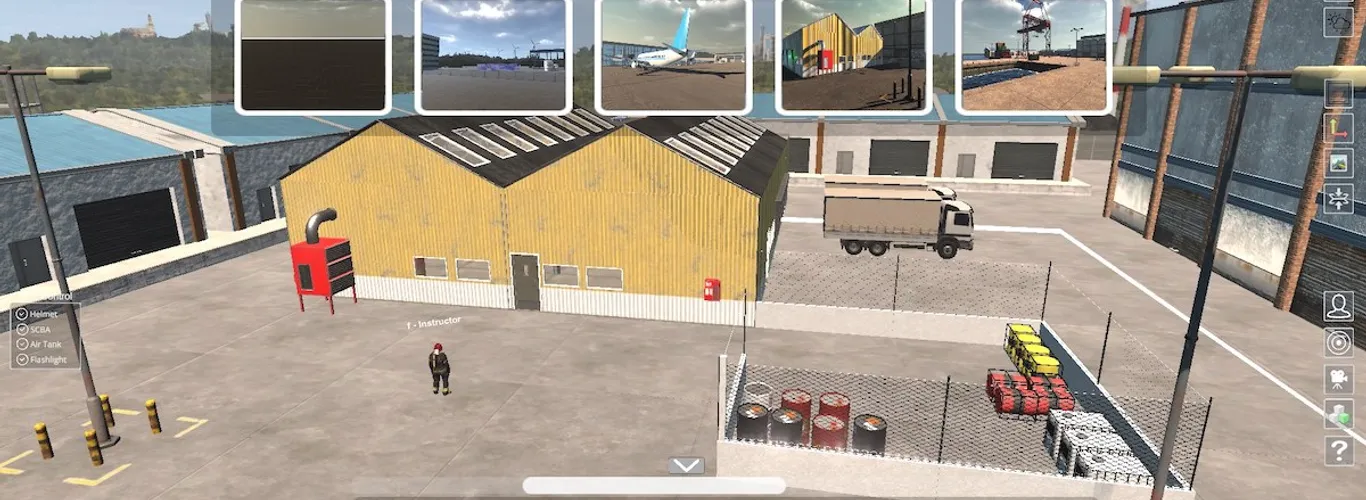
Specialist training courses provided to first responders at airports, training academies, fire services, oil & gas companies and businesses working in high-risk environments are currently delivered using conventional tools such as tabletop exercises where members meet in an informal classroom setting to discuss roles and responsibilities during an emergency and form responses to a particular situation or utilizing training aids such as PowerPoint presentations with static images and videos.
At the other end of the spectrum, simulated large exercise drills can be conducted using complex and expensive command and control software. These can take time to learn, to operate, and cost tens if not hundreds of thousands of dollars in a one-time purchase business model.
To enable fire chiefs and training managers to provide better fire training for their teams, they need to have easy and affordable access to modern-day tools such as virtual reality (VR), augmented reality (AR), and computer-generated imaging (CGI) platforms that provide interactive and realistic training experiences. The US fire administration states that the “use of VR technology allows training for incidents that cannot easily be replicated or may be very costly to recreate, not to mention eliminating the hazards involved in ‘live training'." ARVR Journey also highlights that virtual reality is shaping the new training and development industry in multiple ways.
Lack of versatility and consistency is also an issue. Preparing training material and finding the right images and video content on the internet for every fire training session can be a time-consuming and hit-and-miss task that does not guarantee the same fire training experience across trainees and cohorts. This practice also meant that training managers could be using the same photos or videos on their computers over long periods of time due to the lack of new suitable interactive content which facilitates beneficial training sessions and also impacts training quality.
A Cost-Effective Way for Pre-Incident Planning
As noted by PwC, “employers are facing a dilemma: Their workforce needs to learn new skills, upgrade existing capabilities or complete compliance training, but may not be able to do so in person given the current environment. Yet, training is especially important now, with employees so keen to gain skills, and it may become even more critical when workers start returning to a changing workplace. So how can employers deal with the challenge?”
A mismatch between physical facilities and online simulated ones can also prove problematic. Specific to the fire industry, companies with existing training grounds often intend to replicate physical training in a virtual environment before they go out and conduct the “real” training outside. They want to replicate that live-fire training in a safe virtual setting that looks and feels exactly like the facility they already have; to conduct briefings, debriefings, and pre-incident planning sessions.
Due to the high cost of investing in fire training software, versatile experiences are not available for everyone and that, as a result, it is difficult for trainees to understand the underlying hazards and risks in certain environments correctly.
So, what could be a good solution to solve all these problems and enable fire chiefs and training managers to easily put together an interactive training scene, in a collaborative manner that does not cost tens of thousands of dollars? And how can watch managers at remote fire departments maintain their competencies and keep their teams up to date with their fire training in a cost-effective way?
Software as a Service for the Fire Training, Oil and Gas and Aviation Industry
The answer lies in a SaaS subscription model which can bring down costs, as well as; allow all participants to share their experiences and knowledge to benefit the industry, provide better training for all and at a lower cost across unlimited fire training scenarios. Doing so would simplify building interactive virtual fire training environments for everyone working in a high-hazard industry, so that better training experiences can be delivered to their teams.
This approach improves the quality of fire training being delivered at every location - be it an oil company, a training institution, or an airport. It empowers training managers to recreate simulated hazardous environments and enables them to conduct hazard identification and risk assessment processes more clearly. It also gives them the flexibility to choose from a magnitude of options that have been suggested by their colleagues in the same industry but from a different region.
When expensive training software is prohibitive by high cost, a fire simulation software as a service (SaaS) allows for scale, which results in more firefighters being trained, fewer injuries, and fewer costs to business owners and the industry. Scalability in such a way allows for more people to be trained better, especially at remote fire departments where spending large budgets to train firefighters is not possible.
The benefits of having a subscription-based fire training software not only bring costs down and makes training environments available for everyone, but also being able to deliver better guidance and understanding of the risks involved in a safe environment across a wide range of potential scenarios, ensuring that when first responders are faced with similar incidents in real-life situations they are familiar with it, and they have had the proper training to deal with a wider range of such situations effectively.
The possibilities are endless, and through modern-day technology; firefighters from all over the world can benefit from fire training software to enhance their skills and maintain their competencies while sharing knowledge and experience with their peers.